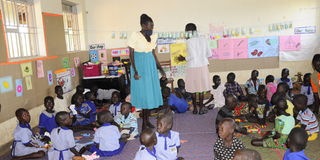Prime
Schools using play to achieve learning goals

Teachers guide pupils during one of the classes at Kitgum Core PTC Demonstration Primary School recently. PHOTO | PROMISE TWINAMUKYE
Children are naturally inclined to play. Also, research shows that people learn best from experiences that are joyful, meaningful, engaging, and socially interactive. Children will not always hit those milestones at the same time – and that is fine. That is the reason they need different kinds of play. Each strand helps them weave a tapestry of strong and flexible of life skills.
In Kitgum Core PTC Demonstration Primary School, the children chatted inaudibly. If you were not keen to peep into the class, you would imagine them playing. Peering through the class window, pupils were playing with different items as their teacher bent over and corrected one of the pupils. When we entered, a Maths class was going on. The pupils were using bottle tops and sticks to create shapes on the floor. When one of them made a mistake in the exercise, the peers quickly corrected them before the teacher intervened.
The Maths teacher said they use play, because pupils understand faster, pay more attention and it sticks because they do not just draw the shapes with pens and pencils. They make the shapes from scratch using available play materials. She said, this also helped with some refugee pupils that do not understand English properly to get immersed in the subject. With support from LEGO among other players, International Rescue Committee leads the $100 million PlayMatters initiative as okayed by the Government of Uganda.
Learning through play is a project which caters to the children between three and 12 years, that was started majorly in refugee settlements in Uganda to make learning more fun and productive, especially for the trauma-stricken children. This initiative currently runs in Lamwo, Adjumani, Obongi Madi-Okollo, Terego, Yumbe, Kyegegwa, Kikuube and Isingiro districts diverging to Tanzania and Ethiopia.
Why play is key
Visiting one of the primary teaching colleges in Kitgum, primary teaching students are taught how to make different materials as one of the methods of imparting knowledge to their learners. The students are taught to make materials as part of their lessons.
“Each subject has a concept of material production on different type of play material depending on the class a student is going to teach,” Denis Oloya, a tutor at Kitgum Core PTC says.
Students are equipped with this skill so that they are able to teach children how to make the materials with or without samples using different local raw materials during teaching practice.
Irene Suzan Adong, a final year student at Kitgum Core Primary Teachers’ College, says they use local materials, (things that are within their reach) while making instruction materials for play. They buy materials that cannot be found locally, for example, the cardboard boxes used for making classrooms, latrines, cars and other art pieces the learners relate with in their environment.
“Through these, we can teach them how to use latrines when they are at home and at school, among other disciplines,” Adong says.
“Art and craft is a mother of material production. Learners can produce these materials through art and craft, and the same materials can be adapted for Literacy One, Mathematics, English and any other subject,” Oloya explains.
Instead of showing them diagrams, this method of learning shows them real objects for better understanding and identifying new words.
Philister Osoru, Play Matters manager based in Lamwo, says the community is still skeptical about how play can facilitate learning.
“The reason one would find a comment on their child’s report card saying the child could do better but they are playful, means they do not yet see the connection between play and learning,” Osoru notes.
Studies show that learning through play helps children develop social, emotional, creative, physical and cognitive skills. Most importantly, it gives children the opportunity to build resilience and imagine their own future.
Regional learning
The initiative, Osoru says, is supposed to reach out to 800, 000 children in the nine districts where Play Matters project is implemented.
Regionally, it was, however realised, that in the three countries where learning through play project is being implemented, each country was implementing it differently. Uganda is successfully implementing the initiative and many schools have started picking up because they are implementing it through system actors, especially the ministry of Education.
Through a conference aimed at bringing together system actors from Tanzania and Ethiopia to see how it is done in Uganda, these actors went to different refugee settlements to see what the teachers and tutors were doing before convening to talk about the lessons learnt.
The takeaways
Eba Mijena, chief excecutive officer for academic affairs in the ministry of Education, Ethiopia observed the active and cheerful engagement during lessons between pupils and teachers.
“It is, especially important for refugee children because of the different trauma faced in their war-stricken countries,” Mijena said. Adding that different system actors in Uganda talk about play matters in unison which is important for the success of any initiative.
“Implementing play in the classroom with the commitment of teachers is vital and that is my takeaway. We will engage in training teachers to improve their commitment and perception towards using play in the classroom,” he said.
Henry Tindwa, education in emergency specialist at Plan International, Tanzania, says they are trying to build capacity of the teachers to move from traditional type of teaching to use innovative ways of using children’s play as tool for learning, while engaging parents as support groups.
“Coming to Uganda, especially Lamwo District, tutors at Kitgum Core Primary Teaching College not only teaches pre-service and in-service teachers how to include play in pupil’s learning,” Tindwa noted.
He added that since adaptation takes time, following up these teachers after they have completed college, helps in cementing this type of learning.




